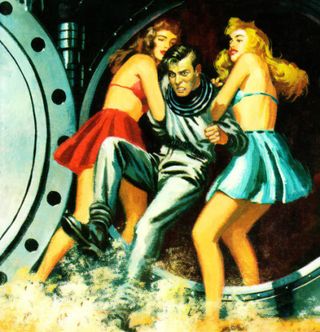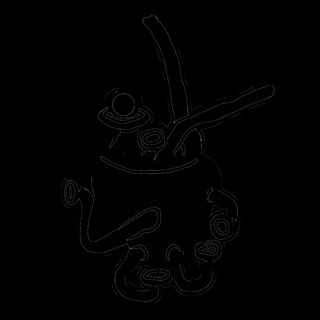Like many games masters, judges, referees, or whatever you like to call them, I have many more adventures and adventure ideas than I'll—sadly—ever be able to run. I've collected amazing one-shots, fabulous books, exciting PDFs, intriguing blog posts and much more, all spanning a variety of settings, themes, and tones.
I had this idea percolating inside my head of a campaign that would span many worlds, where the characters would travel through dimensions and planes of existence. I would use this as the big excuse to string together a whole bunch of these adventures, and it wouldn't matter if they varied radically in tone, or in the technological development of their inhabitants—in fact, it would be expected, since the characters crossed worlds!
I needed three things: a reason for the party to risk their lives in these crazy locations, a means to travel between all of them, and, hardest of all, a game system to run it in.
I thought about this long and hard. The game we were about to finish was Symbaroum, an excellent dark fantasy romp through an oppressing, ancient forest. A "roll under" system, where the character powers are tightly tied to the tone of the setting. I liked a lot of the mechanics, but many of them wouldn't work for a gonzo worlds-spanning game.

Before Symbaroum, we played a lengthier homebrew campaign called Verdant Reaches. We used a modified version of 5th edition D&D for this, mainly when it came to magic. I was aiming for a world where magic was raw, rare, and mysterious. I gave each magic-using class their own spin on magic, with some pseudo-scientific explanations, changed up a bunch of spells, and struck others that really didn't fit.
This worked in the beginning, but became harder and harder as the characters levelled up and gained new abilities and spells. Each of these had to be examined in light of the whole; made harder by D&D's widespread availability of magic, across most classes, too.
I made a final mistake in this campaign: a black swan, a world shattering event, that unravelled magic as everyone knew it. It was my hope that this would give us a new baseline to create new magic, invented and developed by the characters. This might have worked for a very story-driven group of players. It worked less so for my group, who were used to outlined character options and a solid reference for planning character progression. I should have anticipated this, having gamed with this group for a very long time.
I thought about much more cut down systems, like The Black Hack, Lamentations of the Flame Princess, and other OSR favourites. But they all had the same problem as above: few and somewhat vague character progression options, something that was just too important for my players. I'm a huge fan of rules-light systems like The Black Hack, or Breakers, for one-shot games. But in order to maintain the interest of my players over the long term, we need exciting and varied character options, and plenty of them. I thought of Spire and its awesome character classes and advances, but they are inextricably tied to its setting (a great boon for Spire!)

More systems went through my mind: Numenera, or perhaps better yet, The Strange. But ultimately I couldn't shake the thought: "Why not, after an eon of gaming, finally create a system of my own?" After all, I knew what I wanted in a system in order to bring the fun my way, and even more importantly, I knew what my players wanted in a game system in order to remain engaged.
Initial criteria
So I had some requirements that the system would need to fulfill:
- it had to work with existing OSR and system-neutral adventures with on-the-fly conversion,
- it would furthermore ideally work with D&D, 13th Age, and other, "bigger" systems too,
- it needed a solid and intuitive core mechanic,
- it had to support a variety of approaches to magic,
- it needed to let me make judgement calls instead of have rules for every possible interaction,
- it had to provide a plethora of starting character options and progression options.
With those goals in mind I set out to cannibalize all my favourite parts of all the systems I've played, to see how I could mash them together into something new.
On the feet of giants
As you've already guessed, none of this would have come to pass, had I not this vast line of amazing pioneers and game designers go before me. And beyond printed material, many ideas came—or were lifted wholesale—from blog posts, social media discussions, podcasts, in person conversations, and much more. When I publish the system, I will attempt to credit as many sources I looted from as I can remember, but please accept my apologies in advance for those I may miss.
Overall tone
Even though the game will span countless worlds—dubbed the "Ultracosm"—I still needed a general focus. For this I settled on retro futurism and science fantasy, especially from sci-fi magazines of the early 19th century (like Planet Stories, Amazing Stories, et al), but also heavily influenced by the paintings of Frazetta, the Vallejos, Caza, and Caldwell. I put together a Pinterest board with images that capture the tone I'm going for.
As I'm writing the rules and the character powers, I'm paying particular attention to the language used, in order to remain true to this tone. I never use modern words or words that are too loaded in meaning with reference to modern science fiction. Everything should sound more like science fiction and fantasy as envisaged in those publications of old. This helps switching from a medieval world, to one with floating sandships and emitters, with little to no friction and cognitive dissonance. Numenera talks about this too, in the introduction to its world.
Iterative process

Since writing the first draft, we've playtested, adjusted, rewritten, and playtested again for many months. I'm currently on the 3rd major rewrite of the system, based on everything we learned. During each iteration, we noted what worked and what didn't, which powers were clearly too good, and which types of powers were lacking. We experimented with multiple core mechanics, each time focusing on streamlining without sacrifcing depth.
It's my hope that this 3rd revision will be in a publishable state. We have a simple d20 roll with (generally) one modifier, where every ability point counts. There are 3 abilities: Brawn, Agility, and Mind. The target for each roll is the opponent's ability score, or the task's difficulty. Advantage and disadvantage are lifted directly from 5th edition D&D. The round system borrows heavily from Shadow of the Demon Lord.
Unique selling point
So far so good, and all of that is relatively standard fare that could have and probably has already been bashed together by many a homebrew system. But this game has two strengths beyond that: the huge number of character powers and advances, and its Sense of Wonder mechanic.
Having a simple and flexible core rule is of course vital, but it doesn't by itself set the game apart from others, nor does it bring anything unique to the game to the table. In Spire, the character classes and advances are steeped in the lore and tone of the setting. But in a game that spans worlds, this doesn't easily work. So by eliminating the specific content of the worlds characters might visit, I took a step back, and realized that exploration and discovery is an even greater aspect of this game than in even in most.
This felt good: making discoveries themselves an integral part of the mechanics. Enter the Sense of Wonder pool. As characters make discoveries, they gain points in this pool, which is shared among the party. During combat or other situations where the outcome is unsure, and therefore one or more rolls are required, the players have the option of wondrous actions, on top of standard ones. These cost Wonder points, and thus their use requires consent from the other players. But in return they can achieve truly, well, wondrous things. This in turn reinforces the heroic, unlikely, and perhaps even a little gonzo, tone of the game.
The Wonder pool also incentivises exploration, and thus travel between worlds (read: all those adventures from your shelf you want to run).
There is much more to this, but it's all explained in the core rules, so let's talk about something else next.
The name of the game
Yes, the game is called Hypertellurians, implying better than average humans. In fact, the choice of characters goes some way beyond what we might normally think as human. Instead of classes and races, the game has 6 archetypes, which, together with its array of free-choice starting powers, allows for creating a huge number of character concepts.

The archetypes are: the Royal (deposed queen, scheming general, or maybe a magical princess), the Beast (were-leopard, orc, or maybe a mermaid), the Construct (android, juggernaut, golem), the Alien (gas cloud, idea from space, tall and thin thing), the Revenant (vampire, skeleton, creature that should not be), and the Ultranaut (experimental spacecraft astronaut flung through black hole, totalitarian femme fatale occultist).
The archetypes all have their own signature starting powers. Then we have general starting powers like Byronic, Deep Lungs, Different Down There, Sidekick, Tellurian of Unusual Size, and Terrible Curse, to name just a few, that you get to choose from. Finally, each archetype has a set of minor, medium, and major advances, plus generic advances to choose from too.
When?
Very soon. I'm finishing up the general starting powers at the moment, and then I'll have a go at the inventory. Finally, I'll throw together a character sheet. I'll probably release it at about the same time as my group starts playtesting this latest iteration.
Format
Initially, I will be releasing Hypertellurians on this blog, in its own section, with original, and public domain art, and solid graphic design. It'll be a living document for a while, as playtesting notes come in, things are tweaked, and perhaps advances added.
I'm a big fan of web pages for reading and referencing game mechanics, especially if they are designed for the game itself rather than more generic. Having multiple tabs open for different parts of the rules is handy, for example. That said, I'm aware that many people might prefer a PDF they can stick with all their other electronic gaming books. I might investigate a print stylesheet at first that'll let you print to PDF without screwing up the graphic design. As for down the road, we'll have to see.
That's it for now. If you made it this far, congratulations, and my sincerest thanks for your interest in my little hobby project! I will update this page with more information on the game as it evolves, and in the meantime you can look forward to probably another handful of preview or support posts about the game soon.

